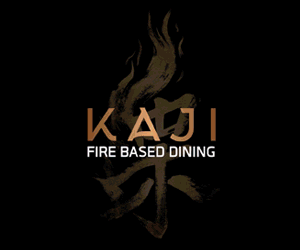DERRY has landmarks aplenty – the Guildhall, the Peace Bridge, the Bogside Murals just three – but there’s no escaping you have to start with the 17th century Walls, never breached, surprisingly complete. To get a grasp on this city with such a tangled history we first took one of Martin McCrossan's (highly recommended) City Walking Tours along those panoramic walkways that have seen so much.
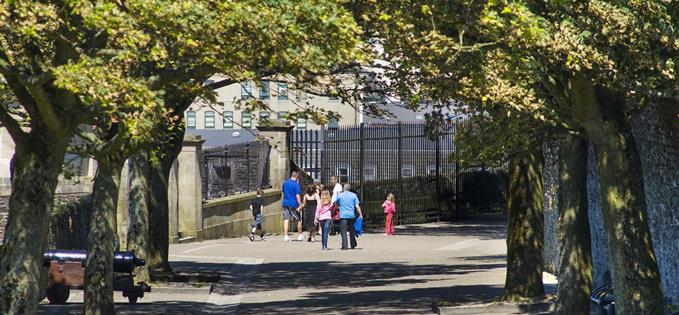 Today's Walls offer a peaceful promenade, but their history is a blood-soaked one
Today's Walls offer a peaceful promenade, but their history is a blood-soaked oneThe last time we’d been in town was back in the 1970s, when the centre looked like a war zone and certain areas outside the Walls certainly were. Our snapshots then would have been very different. Here’s how we saw today’s Derry on a packed long weekend.
A fitting base for a much-changed city
We’d arrived early, very early in Derry. Ryanair’s flight left Liverpool John Lennon at 7.30pm. We’d had a fine night’s sleep in a ‘Dream Bed’ at Widnes Travelodge a convenient eight miles away from the airport but we didn’t feel adjusted to the day until we were settled in for breakfast at our Derry base, the City Hotel.
Dining room and lobby held a fair scattering of musicians, there like us for the new Derry International Irish Music Festival. We got our own star treatment by being allocated one of the top floor suites, named after prominent Derry men. ‘Seamus Heaney’, alas, was taken but we were proud to occupy the homage to John Hume, a key figure in the Peace Process, which has helped transform Derry. From our beautifully equipped lodging we looked down at the Peace Bridge across the Foyle, feeling the join.
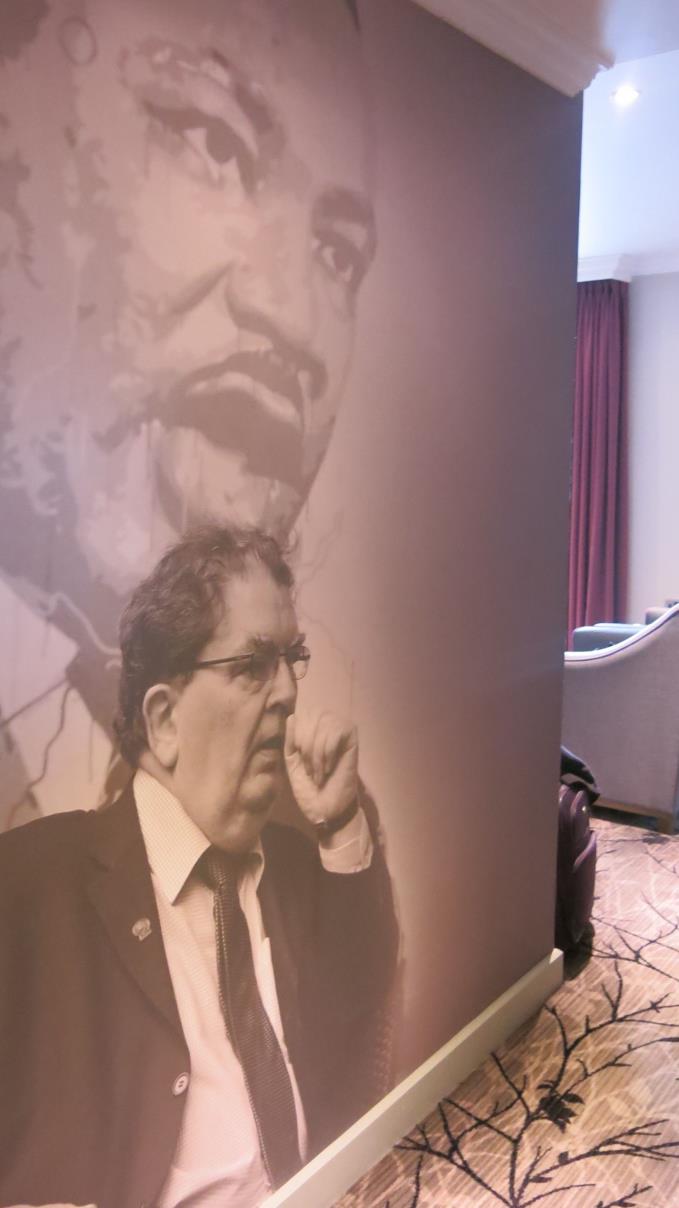 Hulme and Mandela; below, our view of the Peace Bridge
Hulme and Mandela; below, our view of the Peace Bridge
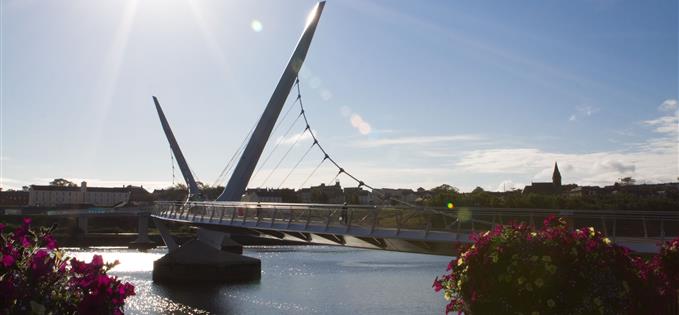
Sweet sounds in the UK City of Culture
Important too is the artistic legacy of being UK City of Culture 2013. The Festival centrepiece was a performance by the stellar Celtic-centric Transatlantic Sessions where Derry’s own Cara Dillon was joined on stage by some of the finest folk players around (North Carolina’s Rhiannon Giddens stole the show), but over the weekend sweet music was made in halls and pubs across the city.
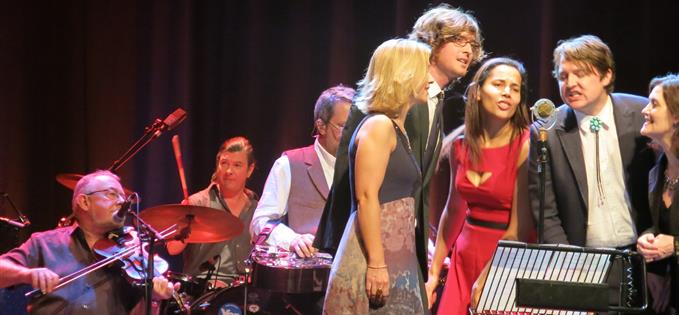 Transatlantic Sessions in full swing
Transatlantic Sessions in full swingThe Sessions took place in utilitarian Noughties build the Millennium Forum; more rewarding architecturally (and free to look around) is the Victorian neo-Gothic Guildhall with its stained glass tracing the city’s history. Regularly damaged during the Troubles – and latterly home to the Saville inquiry into Bloody Sunday – the latest £9.5m restoration has done it proud. Couple it with a visit to one of Ireland’s best museums, the award-winning Tower Museum. Built into the walls, it is big on interactive as it traces the city’s dramatic history. Don’t miss the exhibition about La Trinidad Valencera, one of the Armada’s largest galleons, which sank off the Donegal Coast in 1588 and was rediscovered by local divers in 1971.
Craic and craft ale in a resurgent food and drink scene
Step out of the Guildhall or the Tower Museum and it’s a two minute walk to The Peace Bridge, a curving cycle and footbridge opened in 2011, linking the city centre with Ebrington Square, a decommissioned army barracks, now in the embryo stage of becoming a new leisure and event space incorporating its listed 19th century buildings. Already the former parade ground has hosted Radio One’s Big Weekend and the 2013 Turner Prize was handed out here to tie in with the City of Culture status. Our destination there was the Walled City Brewery.
 Walled City Brewery
Walled City BreweryTo get to this hip American-style brewhouse/restaurant we tottered across the turbulent Foyle in the teeth of the keenest gale February could chuck at us. The trek was worth it. Former Guinness brewer James Huey uses a small kit to produce beers just for this venue. There’s the Derry pale ale ‘Boom’, an IPA called Stitch and Kicks, a pilsner tribute to Derry’s biggest band, The Undertones. Alongside is a roll call of the best in new Irish craft ale – Boundary, Eight Degrees, Poker Tree, Rascals and, a personal favourite, Ballymote Co Sligo’s White Hag plus rival Derry brewers Northbound. Order a flight of four tasting glasses to see what all the fuss is about.
 Small plates from the Walled Brewery kitchens
Small plates from the Walled Brewery kitchensThe food is as carefully thought-out as the striking decor, designed by James’s sister. Ribs, pickles, boxty, laksa, kofta, cured meats – the menu offers a cosmopolitan small plate gathering that hits all the right brewtap fodder notes. Finally, take a look at the world map charting the history of brewing, starting point for a foray into this current champion of malt and hops.
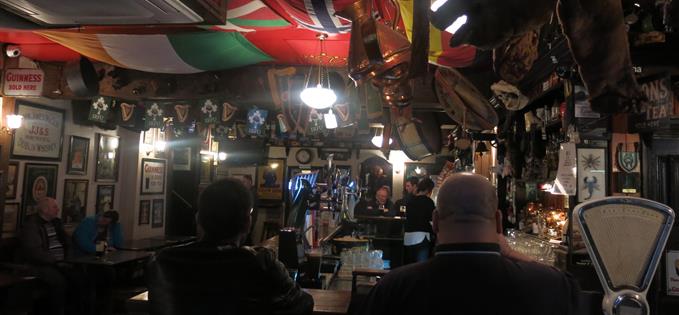 Peadar O'Donnell's is magnificently cluttered; below, Pier 59 sources fine fish
Peadar O'Donnell's is magnificently cluttered; below, Pier 59 sources fine fish
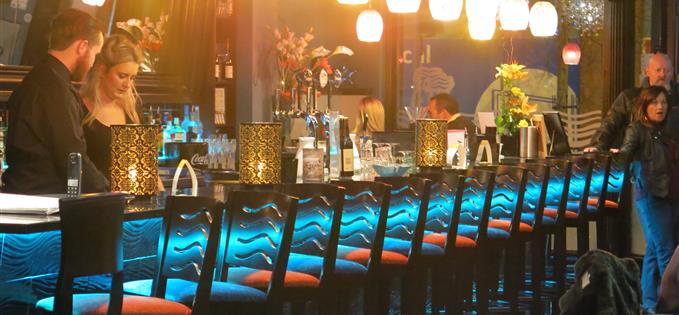
Back in town the trad pubs are a world away from this – try eclectically decked-out Peadar O’Donnell’s on Waterloo Street for fine live music and a mad time or the City Hotel’s nearest local, Grand Central, for a characterful cosy feel and an interesting beer selection (good trad music sessions, too).
A short walk along Strand Road from Grand Central is that blessing in any city, an accomplished seafood restaurant. Family-run Pier 59 sources from local fishermen and boasts radically contemporary interior design for Derry. A few doors away is Brown’s In Town, buzzing sister restaurant to Ian Orr’s Brown’s up at Waterside, one of Ireland’s best restaurants.
We fell in love at first sight with Derry’s stalwart family restaurant, La Sosta, run for 30 years by Claudio and Maureen Antonucci. He, Abruzzo-born, front of house, masterminds a terrific wine list; she, a Derry girl, cooks the lightest, authentic Italian cuisine – classic spinach and ricotta ravioli were feather-light; monkfish fillet came in the subtlest of sauces. The room we ate in was a delight, too. Recommended.
After the delightful diversions, the divisions of history
So that’s today’s city, a joy to visit for a weekend break or as a base to explore wild and wonderful Donegal over in the Republic… and to the east the remarkable Antrim Coast Road and the Giant’s Causeway.
 Our ebbulient City Tour guide John recalls the tangled history of the site
Our ebbulient City Tour guide John recalls the tangled history of the siteBut no one comes to Derry without some knowledge of its recent back story during The Troubles. The Battle of the Bogside and Blood Sunday are still raw wounds for one side; for the other the triumph of King Billy at the Battle of the Boyne is still a burning reason for the annual Orange marches or, in Londonderry (as the Loyalists prefer to call it), the Apprentice Boys parades.
To try and make sense of so much bigotry and violence, but also much courage and loyalty to causes, visit the sides’ respective museums or take a tour. And rejoice that such great steps are being made to move on.
The Traitor Lundy and the Apprentice Boys
Funny how I’d always thought of Lundy as just a quiet little island off the coast of Devon, home to seals and puffins. Not some execrated Ulsterman, first name Robert, burned in effigy on the streets of Derry every year to celebrate the lifting of a great siege some 350 years ago.

The ‘Traitor Lundy’ was made governor of Protestant ‘Londonderry’ in 1688, against the advance of James II’s Jacobite forces. Heavily defeated and pinned back to the city, he advocated surrender, arousing general fury and was forced to flee. All colourful stuff. One account has him in disguise carrying a load of matchwood on his back to protect him from musket fire, while another says he shinned down a pear tree that grew close to the walls.
They don’t forget easily in these parts. His name remains a term of abuse. The Rev Ian Paisley denounced both Margaret Thatcher and former First Minister David Trimble as ‘Lundies.’
‘No surrender’ hails from this momentous time. It’s what the 13 Apprentice Boys yelled when they slammed the gates on the Catholic invaders, initiating 105 days of desperate siege, during which the inhabitants were reduced to eating rats and dogs. It has become a potent symbol of the Orange cause in an often divided Ulster, celebrated with the Relief Parade every second Saturday in August. To see Lundy go up in flames Guy Fawkes style you have to attend the December ‘Shutting of the Gate’.
Before The Troubles they provocatively used to do this on General Walker’s Pillar on the Walls overlooking the Catholic Bogside. Until those spoilsports, the Provisional RA blew the pillar up in 1973.
 Apprentice Boys Museum
Apprentice Boys MuseumToday’s serene promenade belies such a violent recent history. Do drop in on the spanking new Siege Museum, attached to the Apprentice Boys Memorial Hall. We were privileged to have a guided tour with the General Secretary of this fraternal organisation, Billy Moore, shown videos of the marches and Siege mementoes. Afterwards he took us to the long room where they create the 40ft high Lundy effigy. It’s made horizontally, then winched out. Also, among various very male-centric Orange meeting rooms, we strayed into the inner sanctum of the Black Receptory, a ‘senior religious order’ of the Orange Order. All a bit Masonic. No, I’m still not sure what it all means…
The Bogside and Bloody Sunday – feeling the pain
 Bogside, looking down from the Walls at the entrance to 'Free Derry'
Bogside, looking down from the Walls at the entrance to 'Free Derry'Disconcertingly, step outside the Apprentice Boys HQ and you can gaze down at the Catholic Bogside and, further up the hill, Creggan, the housing estate that was the Provisional IRA stronghold when ‘Free Derry’ was a no-go zone even to British troops. The most striking aspect of this urban jumble are the giant murals created by brothers Tom and William Kelly and Kevin Hasson, the Bogside Artists.
We saw them at close quarters the following day on one of the Bogside History Tours organised by Paul Doherty, son of Patrick Doherty, among 26 unarmed civilians shot dead by British troops during a protest march against internment on January 30, 1972 – Bloody Sunday. A walking tour costs just £6 (taxi tours £25) – this is not about making profits, it’s about explaining what really happened. Lest we forget.
Physically the site of the massacre has altered, the Rossville tenements pulled down, but our walk with a guide who had experienced those times summoned up vividly the ghosts from that terrible day. Lots of X marks the bloody spot.
 Death of Innocence
Death of InnocenceThe murals on the side of houses are remarkable. Here’s the Republican fervour of Bernadette McCluskey (nee Devlin), hero of 1969’s Battle of the Bogside, which spawned the resurgence of the IRA. There’s the most poignant of the paintings – the Death of Innocence, commemorating 14-year-old Annette McGavigan who was killed in crossfire between the British army and the IRA in 1971. She was the 100th victim of The Troubles; recently I discovered a friend knew the family; they never recovered from her loss.
 Bernadette Devlin, an emblematic figure in the Sixties and Seventies
Bernadette Devlin, an emblematic figure in the Sixties and SeventiesFinally, a dove, eternal symbol of peace, emerges from an oak leaf – Derry’s emblem – on the brightly coloured Peace Mural painted on a Rossville Street gable end over a decade ago after local kids were consulted for their ideas.
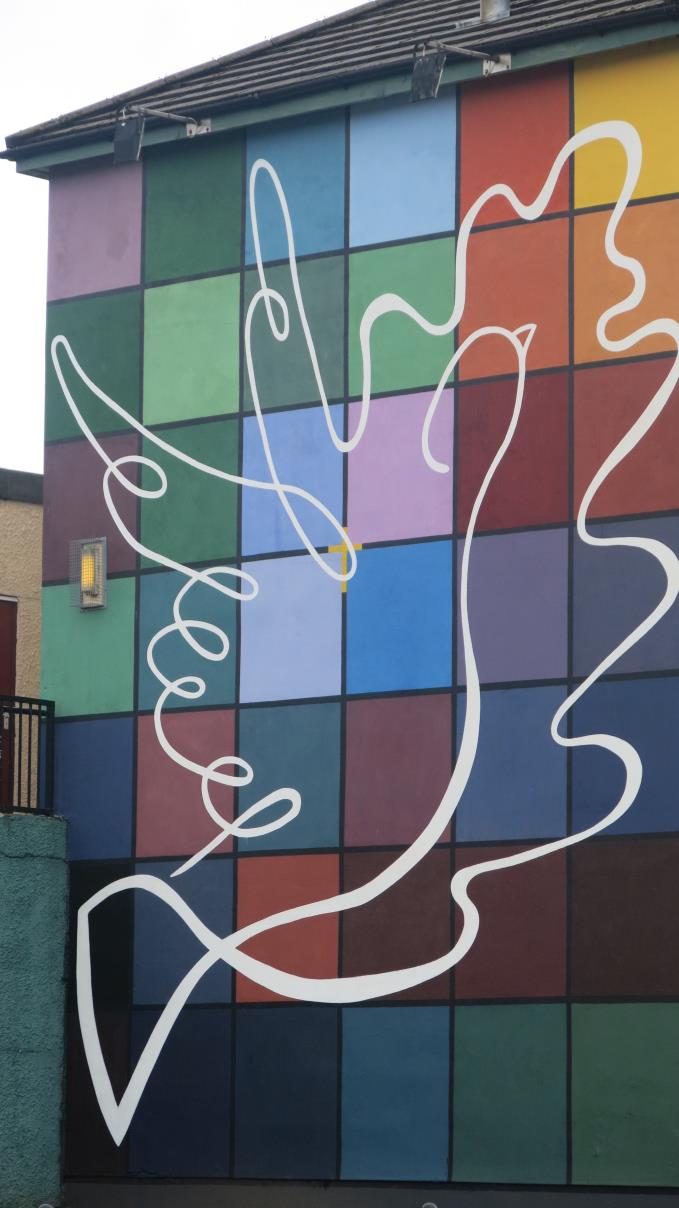 The Peace Mural arose out of the imagination of local children
The Peace Mural arose out of the imagination of local childrenIn the summer of 2016 the Murals will be joined by the custom-built Museum of Free Derry. This archive of the civil rights movement and The Troubles is temporarily housed At 39 Shipwright Street until the new ‘Bloody Sunday Centre’ premises are finished in Glenfada Park. Then there’ll be room to display properly the 25,000 individual items – from shocking images to bloodstained garments – relating to the period, which still casts a long shadow over this compelling city.
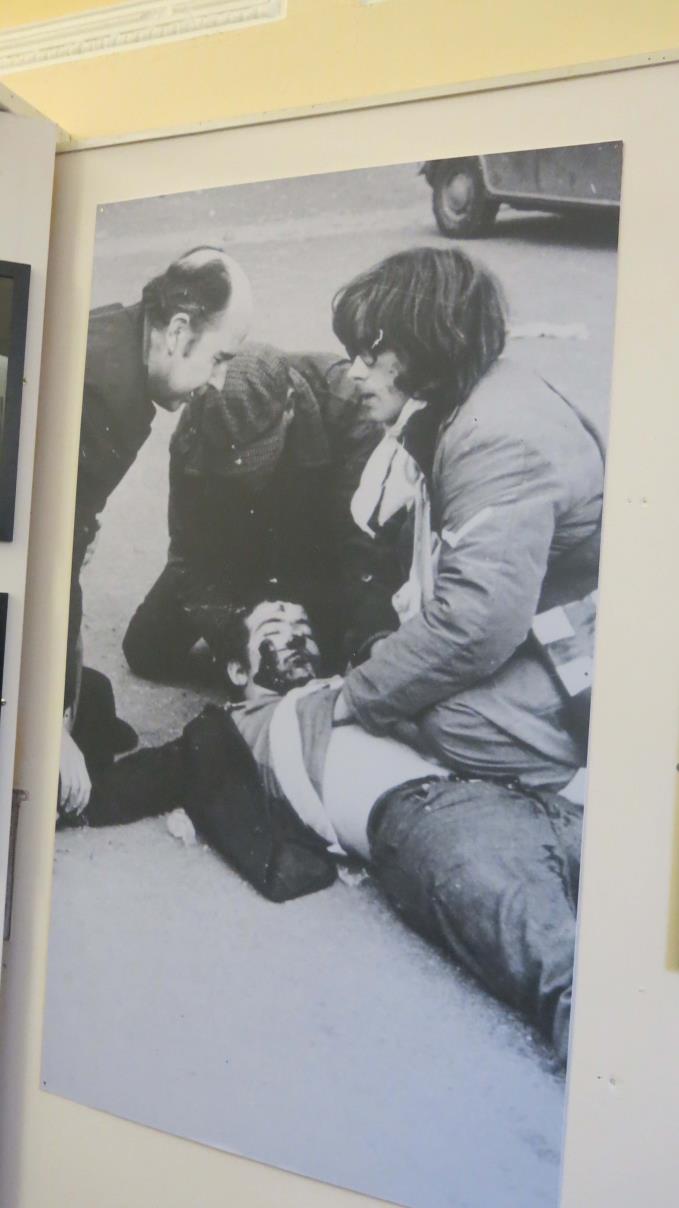
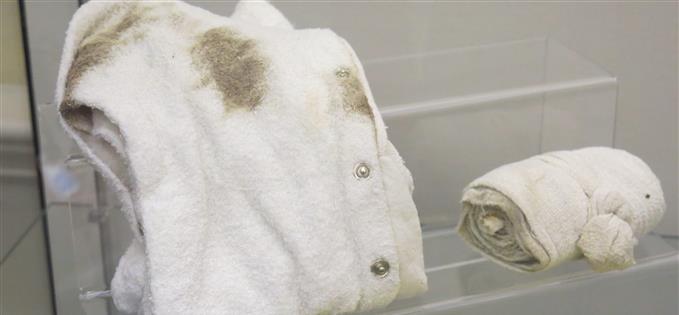 Bloody Sunday archive is a shocking reminder of a tragic day
Bloody Sunday archive is a shocking reminder of a tragic day
Factfile
Neil stayed at the City Hotel, Queens Quay, Derry, County Londonderry. BT48 7AS +44 (0)2871 365 800. They currently have a shopping break offer which includes 2 nights stay with full Irish breakfast on each morning, and £20 shopping voucher from £79 mid week & £99 weekend (subject to availability). Neil stayed in one of the top floor suites – The John Hume Suite, where start from £149.
For full tourism information: Visit Derry.
Neil Sowerby flew to Ireland on the Ryanair service from Liverpool to City of Derry Airport, with average return fares around £50. In order to catch the 7am easyJet service from Liverpool John Lennon Neil stayed handily seven miles away at the Widnes Travelodge, one of the budget chain’s freshly upgraded hotels, featuring the king-sized Travelodge Dreamer Bed. To book at any of their 500 hotels visit this link.
 Two Murals: IRA hunger strikers with their mothers; below, once a no-go zone
Two Murals: IRA hunger strikers with their mothers; below, once a no-go zone
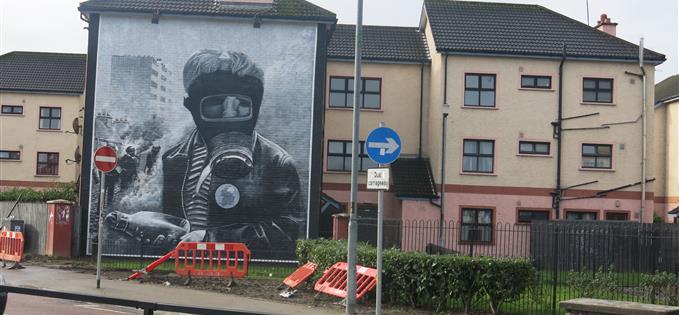
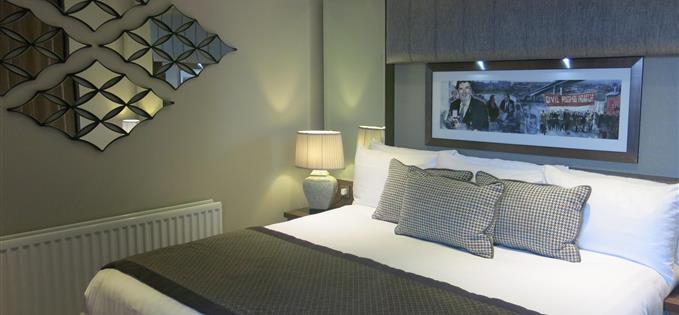 Our Hulme Suite celebrates a great peacemaker; below the Heaney Suite a great poet
Our Hulme Suite celebrates a great peacemaker; below the Heaney Suite a great poet






